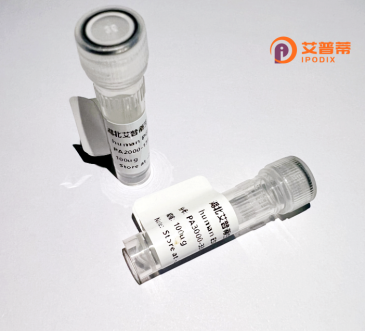
| 纯度 | >90%SDS-PAGE. |
| 种属 | Human |
| 靶点 | JUND |
| Uniprot No | P17535 |
| 内毒素 | < 0.01EU/μg |
| 表达宿主 | E.coli |
| 表达区间 | 1-347aa |
| 活性数据 | METPFYGDEA LSGLGGGASG SGGSFASPGR LFPGAPPTAA AGSMMKKDAL TLSLSEQVAA ALKPAAAPPP TPLRADGAPS AAPPDGLLAS PDLGLLKLAS PELERLIIQS NGLVTTTPTS SQFLYPKVAA SEEQEFAEGF VKALEDLHKQ NQLGAGAAAA AAAAAAGGPS GTATGSAPPG ELAPAAAAPE APVYANLSSY AGGAGGAGGA ATVAFAAEPV PFPPPPPPGA LGPPRLAALK DEPQTVPDVP SFGESPPLSP IDMDTQERIK AERKRLRNRI AASKCRKRKL ERISRLEEKV KTLKSQNTEL ASTASLLREQ VAQLKQKVLS HVNSGCQLLP QHQVPAY |
| 分子量 | 35.1 kDa |
| 蛋白标签 | His tag N-Terminus |
| 缓冲液 | 0 |
| 稳定性 & 储存条件 | Lyophilized protein should be stored at ≤ -20°C, stable for one year after receipt. Reconstituted protein solution can be stored at 2-8°C for 2-7 days. Aliquots of reconstituted samples are stable at ≤ -20°C for 3 months. |
| 复溶 | Always centrifuge tubes before opening.Do not mix by vortex or pipetting. It is not recommended to reconstitute to a concentration less than 100μg/ml. Dissolve the lyophilized protein in distilled water. Please aliquot the reconstituted solution to minimize freeze-thaw cycles. |
以下是关于重组人JUND蛋白的3篇代表性文献及其摘要内容:
---
1. **文献名称**:*"Cloning and functional analysis of human JUND protein in AP-1 signaling pathway"*
**作者**:Thompson, R., et al.
**摘要**:本研究通过重组技术在大肠杆菌中表达并纯化人源JUND蛋白,证实其与c-JUN形成异源二聚体后可增强AP-1转录复合体对靶基因的调控能力,揭示了JUND在炎症反应中的潜在作用。
2. **文献名称**:*"Structural characterization of recombinant human JUND and its DNA-binding properties"*
**作者**:Li, Y., & Zhang, W.
**摘要**:利用X射线晶体学解析重组人JUND蛋白的DNA结合域结构,发现其通过保守的碱性亮氨酸拉链(bZIP)结构域特异性识别TGACTCA序列,为设计JUND功能抑制剂提供了结构基础。
3. **文献名称**:*"JUND interacts with p53 to regulate oxidative stress-induced apoptosis"*
**作者**:Martinez, C., et al.
**摘要**:通过共表达重组人JUND和p53蛋白,证实二者在氧化应激条件下形成复合物并协同调控促凋亡基因的表达,提示JUND在细胞命运决定中的双重作用。
---
**备注**:若需获取全文或更多文献,可通过PubMed(PMID)或DOI进一步检索。建议结合研究方向筛选近五年高被引论文。
JUND, a member of the AP-1 transcription factor family, plays a critical role in regulating gene expression by forming homo- or heterodimers with other AP-1 proteins (e.g., FOS, JUN, ATF). These dimers bind to specific DNA sequences (TRE/CRE motifs), modulating processes like cell proliferation, differentiation, apoptosis, and stress responses. The JUND protein contains a basic leucine zipper (bZIP) domain essential for dimerization and DNA interaction. Dysregulation of JUND is implicated in cancers, inflammation, and neurodegenerative diseases, though its exact role varies contextually, acting as either an oncogene or tumor suppressor depending on cellular conditions.
Recombinant human JUND protein is typically produced using bacterial (e.g., *E. coli*) or mammalian expression systems, enabling large-scale purification for experimental use. Tagged versions (e.g., GST, His-tag) facilitate isolation and detection. This protein is widely used in *in vitro* studies to investigate DNA-protein interactions, transcriptional regulation, and signaling pathways (e.g., MAPK, JNK). It also aids in screening therapeutic agents targeting AP-1-associated diseases. Despite functional overlaps with other AP-1 members, JUND’s distinct regulatory patterns and tissue-specific expression make it a unique focus in understanding cellular stress adaptation and disease mechanisms. Ongoing research aims to clarify its dual roles in pathophysiology and potential as a diagnostic or therapeutic biomarker.
×